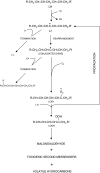Role of free radicals in liver diseases
- PMID: 19941170
- PMCID: PMC2790593
- DOI: 10.1007/s12072-009-9158-6
Role of free radicals in liver diseases
Abstract
Reactive oxygen and nitrogen species (ROS and RNS) are produced by metabolism of normal cells. However, in liver diseases, redox is increased thereby damaging the hepatic tissue; the capability of ethanol to increase both ROS/RNS and peroxidation of lipids, DNA, and proteins was demonstrated in a variety of systems, cells, and species, including humans. ROS/RNS can activate hepatic stellate cells, which are characterized by the enhanced production of extracellular matrix and accelerated proliferation. Cross-talk between parenchymal and nonparenchymal cells is one of the most important events in liver injury and fibrogenesis; ROS play an important role in fibrogenesis throughout increasing platelet-derived growth factor. Most hepatocellular carcinomas occur in cirrhotic livers, and the common mechanism for hepatocarcinogenesis is chronic inflammation associated with severe oxidative stress; other risk factors are dietary aflatoxin B(1) consumption, cigarette smoking, and heavy drinking. Ischemia-reperfusion injury affects directly on hepatocyte viability, particularly during transplantation and hepatic surgery; ischemia activates Kupffer cells which are the main source of ROS during the reperfusion period. The toxic action mechanism of paracetamol is focused on metabolic activation of the drug, depletion of glutathione, and covalent binding of the reactive metabolite N-acetyl-p-benzoquinone imine to cellular proteins as the main cause of hepatic cell death; intracellular steps critical for cell death include mitochondrial dysfunction and, importantly, the formation of ROS and peroxynitrite. Infection with hepatitis C is associated with increased levels of ROS/RNS and decreased antioxidant levels. As a consequence, antioxidants have been proposed as an adjunct therapy for various liver diseases.
Figures




Similar articles
-
Cooperation of liver cells in health and disease.Adv Anat Embryol Cell Biol. 2001;161:III-XIII, 1-151. doi: 10.1007/978-3-642-56553-3. Adv Anat Embryol Cell Biol. 2001. PMID: 11729749 Review.
-
[The role of oxidative/nitrosative stress in pathogenesis of paracetamol-induced toxic hepatitis].Med Pregl. 2010 Nov-Dec;63(11-12):827-32. doi: 10.2298/mpns1012827r. Med Pregl. 2010. PMID: 21553462 Review. Serbian.
-
Free radicals and antioxidants in normal physiological functions and human disease.Int J Biochem Cell Biol. 2007;39(1):44-84. doi: 10.1016/j.biocel.2006.07.001. Epub 2006 Aug 4. Int J Biochem Cell Biol. 2007. PMID: 16978905 Review.
-
Hyperacute rejection in the xenogenic transplanted rat liver is triggered by the complement system only in the presence of leukocytes and free radical species.Xenotransplantation. 2013 May-Jun;20(3):177-87. doi: 10.1111/xen.12035. Epub 2013 May 9. Xenotransplantation. 2013. PMID: 23656281
-
Reactive oxygen species mediate human hepatocyte injury during hypoxia/reoxygenation.Liver Transpl. 2010 Nov;16(11):1303-13. doi: 10.1002/lt.22157. Liver Transpl. 2010. PMID: 21031546
Cited by
-
Oxidative stress responses as a marker of toxicity in mice exposed to polluted groundwater from an automobile junk market in South-Western Nigeria.Cell Stress Chaperones. 2022 Nov;27(6):685-702. doi: 10.1007/s12192-022-01305-w. Epub 2022 Nov 2. Cell Stress Chaperones. 2022. PMID: 36322346 Free PMC article.
-
An overview on the proposed mechanisms of antithyroid drugs-induced liver injury.Adv Pharm Bull. 2015 Mar;5(1):1-11. doi: 10.5681/apb.2015.001. Epub 2015 Mar 5. Adv Pharm Bull. 2015. PMID: 25789213 Free PMC article. Review.
-
Long-Term Saccharin Consumption and Increased Risk of Obesity, Diabetes, Hepatic Dysfunction, and Renal Impairment in Rats.Medicina (Kaunas). 2019 Oct 9;55(10):681. doi: 10.3390/medicina55100681. Medicina (Kaunas). 2019. PMID: 31601053 Free PMC article.
-
Delivery of Lipid Nanoparticles with ROS Probes for Improved Visualization of Hepatocellular Carcinoma.Biomedicines. 2023 Jun 21;11(7):1783. doi: 10.3390/biomedicines11071783. Biomedicines. 2023. PMID: 37509423 Free PMC article.
-
Potential therapeutic effect of thymoquinone and/or bee pollen on fluvastatin-induced hepatitis in rats.Sci Rep. 2021 Aug 3;11(1):15688. doi: 10.1038/s41598-021-95342-7. Sci Rep. 2021. PMID: 34344946 Free PMC article.
References
-
- Tsukamoto H. Conceptual importance of identifying alcoholic liver disease as a lifestyle disease. J Gastroenterol. 2007;42:603–609. - PubMed
-
- Luzio NR. A mechanism of the acute ethanol-induced fatty liver and the modification of liver injury by antioxidants. Lab Invest. 1966;15:50–63. - PubMed
-
- Minicis S, Brenner DA. Oxidative stress in alcoholic liver disease: role of NADPH oxidase complex. J Gastroenterol Hepatol. 2008;23:S98–S103. - PubMed
-
- Nordmann R, Ribiere C, Rouach H. Implication of free radical mechanisms in ethanol-induced cellular injury. Free Radic Biol Med. 1992;12:219–240. - PubMed
-
- Cederbaum AI. Microsomal generation of reactive oxygen species and their possible role in alcohol hepatotoxicity. Alcohol Alcohol. 1991;1:S291–S296. - PubMed
LinkOut - more resources
Full Text Sources
Other Literature Sources
Research Materials

